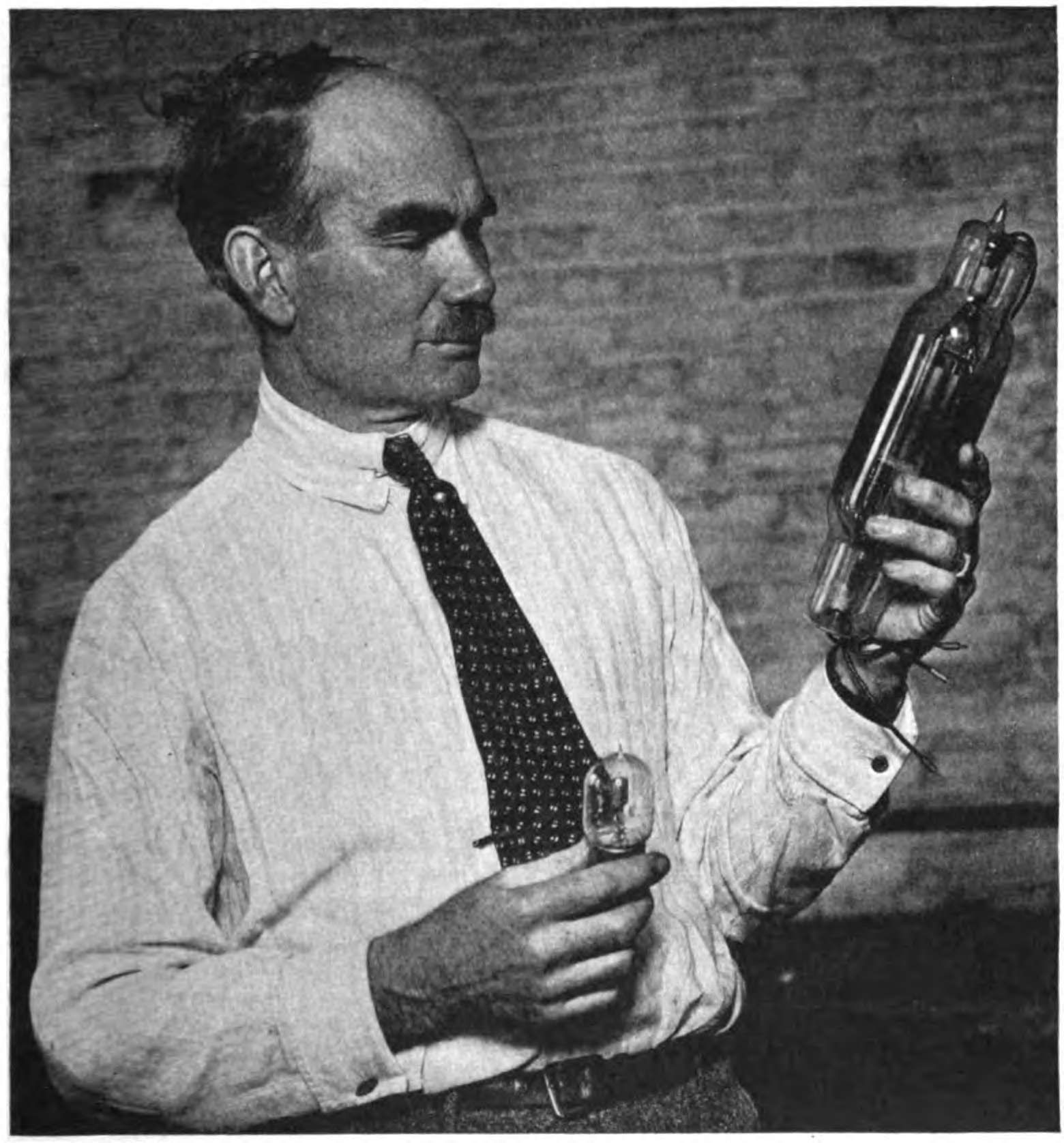Introduction
Born in 1873 in Council Bluffs, Iowa, Lee de Forest was an American inventor who is best known for his invention of the Audion tube, the first practical electronic amplifier. His work laid the groundwork for the development of all electronic media.
Throughout his career, de Forest patented over 300 inventions, with the Audion tube being his most famous. This innovation not only enabled long-distance phone calls and radio broadcasting but also set the stage for the advent of television, radar, and eventually, the computer.
The Audion tube revolutionized radio technology by making it possible to amplify weak signals, allowing for longer-distance communication. This was pivotal for amateur radio enthusiasts, enabling the hobby to grow and evolve.
de Forest’s work has had a lasting influence on modern electronics and communication. The principles behind his inventions underpin many technologies we use today, from broadcasting to the infrastructure of the internet. His contributions are a cornerstone in the edifice of contemporary electronics and amateur radio, demonstrating how foundational discoveries can pave the way for future innovations.
- Introduction
- Early Life and Education
- Childhood and family background
- Early interest in science and technology
- Education at Mount Hermon School and Yale University
- Influence of professors and mentors on de Forest’s development
- Early Career and Research
- Work at the Federal Telegraph Company and the United States Volunteer Signal Corps
- Experimentation with wireless telegraphy and radio transmission
- Development of early radio devices, including the “responder” and “relay”
- The Audion and de Forest’s Breakthrough
- Development of the Audion, the first amplifying vacuum tube
- Principles of operation and technical details of the Audion
- Patents and disputes surrounding the Audion
- Improvements and Refinements
- Development of later versions of the Audion, including the “amplifying tube” and “three-element tube”
- Improvements to vacuum tube design and manufacturing processes
- Experiments with tube applications, including radio telephony and detection
- The Triode and Its Impact
- Development of the triode, the first practical amplifying tube
- Technical details of the triode’s operation and design
- Impact of the triode on radio technology and amateur radio operations
- Later Career and Legacy
- de Forest’s work in the 1920s and 1930s, including the development of television and FM radio
- Later inventions and innovations, including the “phantom circuit” and “space charge tube”
- de Forest’s legacy and influence on modern electronics and amateur radio
- Controversies and Disputes
- Patent disputes with other inventors, including Edwin Armstrong and Guglielmo Marconi
- Accusations of plagiarism and intellectual property theft
- de Forest’s response to criticisms and controversies
- Conclusion
- Further Reading
Early Life and Education
Childhood and family background
Lee de Forest was born on August 26, 1873, in Council Bluffs, Iowa, as part of a strongly religious family. His father was a Congregational church minister who expected de Forest to follow in his religious footsteps, a path he would diverge from early on.
Despite this clerical family background, de Forest displayed a proclivity towards science and mechanics, an interest that was not directly supported but indirectly fostered through the fundamental educational values espoused by his household.
Early interest in science and technology
de Forest’s youth was marked by numerous experiments and hobbies that leaned heavily towards the mechanical and the electrical. At a young age, he was known to disassemble household gadgets to understand their workings, in addition to conducting basic experiments with available materials.
His burgeoning interest was further fueled by access to scientific literature of the time, including the works and discoveries being published in popular and academic journals. This exposure was critical in shaping his curiosity and ambition towards innovations in science and technology.
Education at Mount Hermon School and Yale University
de Forest excelled academically, securing a place at the prestigious Mount Hermon School in Massachusetts, followed by an enrollment at Yale University. At Yale, he displayed a significant aptitude for electrical engineering, a field that was still in its infancy. His time at Yale was marked by notable achievements, culminating in his graduation with a Ph.D. in Physics.
While at Yale, de Forest was active in extracurricular activities, especially those that aligned with his scientific interests. He was involved in early radio clubs and societies, which allowed him to explore outside the structured curriculum and apply his theoretical knowledge in practical scenarios.
Influence of professors and mentors on de Forest’s development
At Yale, de Forest was influenced by several key figures, including Professor Willard Gibbs, who is renowned for his contributions to thermodynamics, and Professor Henry Augustus Rowland, known for his work in physics. These mentors played a critical role in shaping de Forest’s approach to scientific research and experimentation.
Their guidance and support were instrumental in steering de Forest towards his later achievements. These mentors not only imparted knowledge and academic rigor but also encouraged him to pursue his interests in radio waves and electronics, fields that were just starting to emerge. Their impact was profound, setting de Forest on his path to becoming a pioneer in electronic communications.
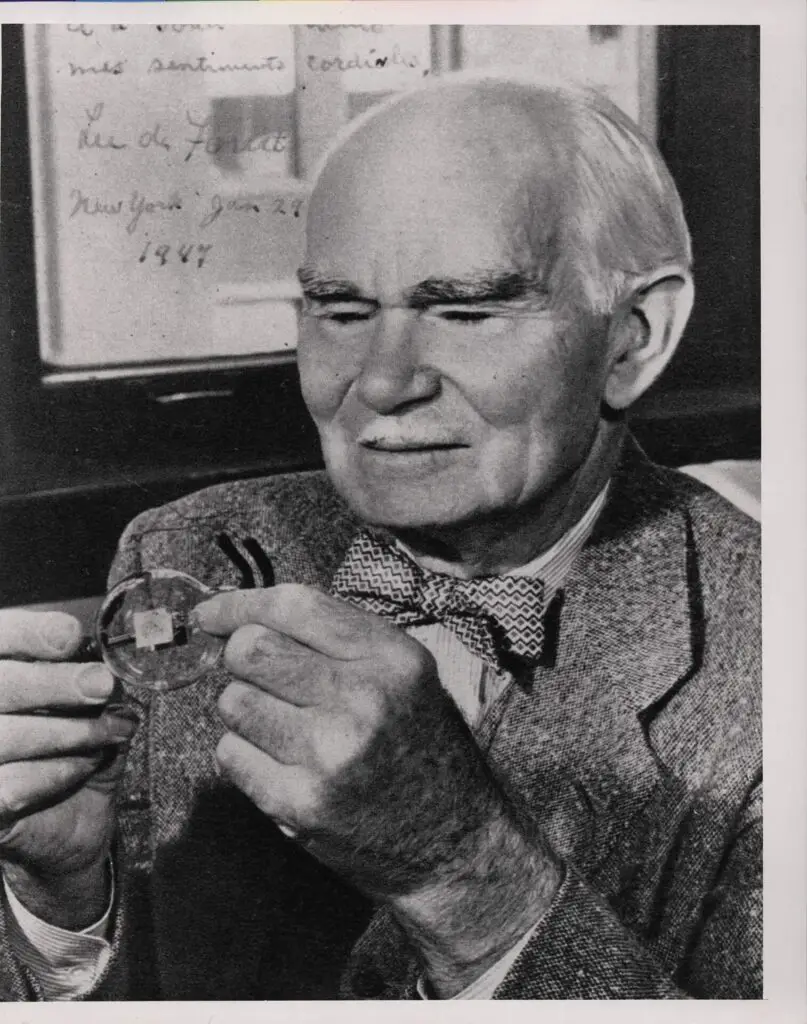
Early Career and Research
Work at the Federal Telegraph Company and the United States Volunteer Signal Corps
Soon after completing his education, de Forest was employed by the Federal Telegraph Company, where he was tasked with improving wireless equipment for ship-to-shore communication systems. His roles and responsibilities here laid the foundation for his understanding of practical wireless communication. Concurrently, his involvement with the United States Volunteer Signal Corps during the Spanish-American War provided him with first-hand experience in military communication technologies and their limitations.
At the Federal Telegraph Company, de Forest was assigned to projects that aimed at enhancing the clarity and range of wireless signals. One significant project was the development of a more sensitive and reliable Morse code receiver, which was critical for the era’s predominant mode of electronic communication.
Experimentation with wireless telegraphy and radio transmission
de Forest’s early experiments were driven by a desire to improve upon the existing wireless telegraphy technology of the time. He focused on enhancing the audibility of signals, exploring different types of detectors and tuning methods. His findings included notable improvements in the sensitivity and selectivity of wireless receivers, although these initial experiments often met with technical challenges and skepticism from the established scientific community.
The biggest challenges de Forest faced included the technical limitations of the components available at the time, such as the reliability of detectors and the efficiency of transmitters. Additionally, there were institutional obstacles, as his ideas were often ahead of their time and not immediately accepted by peers and potential investors.
Development of early radio devices, including the “responder” and “relay”
Among de Forest’s notable early inventions was the “responder,” a device designed to improve the fidelity of radio signal reception by acting as a primitive amplifier. Following this, he developed the “relay,” which was an early attempt to use electromagnetic phenomena to amplify weak signals automatically. These inventions were pivotal, as they addressed some of the primary concerns regarding the efficiency and effectiveness of wireless transmission and reception at the time.
The reception and impact of these early inventions were mixed. On one hand, they demonstrated de Forest’s innovative approach to overcoming the technical challenges of early radio transmission. On the other hand, they were also met with skepticism and legal challenges from competitors and established figures in the field of wireless communication. Despite these challenges, de Forest’s work on the responder and relay contributed significantly to the evolution of radio technology, paving the way for his later, more recognized contributions to electronic amplification and broadcasting.
The Audion and de Forest’s Breakthrough
Development of the Audion, the first amplifying vacuum tube
The inspiration for the Audion came from de Forest’s continuous pursuit to improve wireless communication technology, especially the quest for a more effective way to amplify weak radio signals. The conceptual leap was to modify existing diode vacuum tubes (then used primarily as detectors) to incorporate an additional element—the grid—for signal amplification.
The experimental process involved rigorous testing and refinements of the Audion’s initial design. de Forest experimented with various configurations of the vacuum tube, adding a control grid between the cathode (electron emitter) and anode (plate) to modulate the flow of electrons. Through trial and error, he identified optimal materials, vacuum levels, and grid structures to achieve effective amplification.
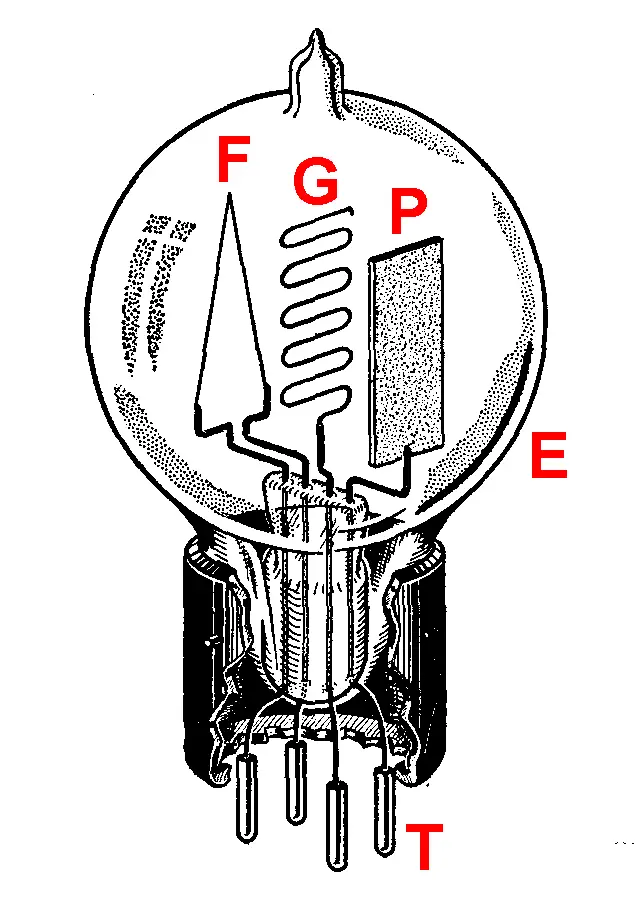
Principles of operation and technical details of the Audion
The Audion operates by controlling the flow of electrons from a heated filament or cathode to a positively charged plate or anode within a vacuum tube. The introduction of a control grid between the cathode and the anode allows the tube to act as an amplifier: small changes in the voltage applied to the grid produce large changes in the plate current, thereby amplifying the incoming signal.
Key components of the Audion include the cathode, the control grid, and the anode, all enclosed within a glass envelope from which air has been evacuated to create a vacuum. The design elements critical for its operation include the positioning of the grid relative to the cathode and anode, the material and structure of the grid, and the vacuum level within the tube. These factors determine the efficiency and amplification factor of the vacuum tube.
Patents and disputes surrounding the Audion
de Forest filed multiple patent applications for his inventions related to the Audion, securing several key patents that covered the device’s operation and its use as an amplifier. His claims were broad, encompassing the use of the Audion for signal detection and amplification across a range of applications, from radio reception to frequency oscillation for transmission.
The revolutionary nature of the Audion’s amplification capability led to numerous challenges and controversies, both in the patent office and in the courts. Notable disputes arose with major figures and corporations in the burgeoning field of electronics, including arguments over priority and the scope of de Forest’s patents. Some contemporaries contested the originality and novelty of de Forest’s work, leading to protracted legal battles. Despite these challenges, the importance of de Forest’s contributions was eventually recognized, and the Audion tube became foundational to the development of electronic communication, radio broadcasting, and the field of electronics itself.
Improvements and Refinements
Development of later versions of the Audion, including the “amplifying tube” and “three-element tube”
Following the original Audion, de Forest and other inventors and engineers continued to enhance and modify the design to increase its reliability, efficiency, and amplification capabilities. Notably, the “amplifying tube” and “three-element tube” (the latter essentially being another name for the improved Audion) featured refined grid designs, better vacuum seals, and more stable and effective cathode materials. These changes resulted in a significant boost in the performance of the vacuum tubes, making them more suitable for a wide range of applications.
The new versions of the vacuum tube demonstrated enhanced performance characteristics, including greater signal amplification, reduced noise, and more consistent operation over time. These improvements expanded the practical applications of vacuum tubes far beyond what was initially anticipated, setting the stage for their ubiquitous use in electronic circuits.
Improvements to vacuum tube design and manufacturing processes
Advancements in materials science and precision manufacturing techniques played a critical role in the evolution of vacuum tube technology. New cathode materials that offered longer life and more stable electron emission were developed, while improvements in glassblowing and metalworking improved the tubes’ vacuum seals and overall durability. The introduction of standardized tube bases and improved electrode structures also contributed to the heightened performance and reliability of these devices.
Alongside these material and component-level advancements, the manufacturing processes of vacuum tubes were streamlined for mass production. Innovations in assembly line techniques and testing methodologies enabled the high-volume production of vacuum tubes, significantly reducing their cost and making them more accessible for commercial and military applications.
Experiments with tube applications, including radio telephony and detection
With the improved capabilities of the latest vacuum tubes, inventors and engineers began exploring new uses for this technology. One area of significant development was radio telephony, where the improved amplification and frequency response of the tubes allowed for the first practical transmission of voice signals over long distances. Additionally, vacuum tubes were integral in the advancement of signal detection and modulation techniques, contributing to the development of early electronic music instruments, medical equipment, and radar systems.
These experiments not only demonstrated the versatility and potential of vacuum tube technology but also laid the groundwork for future innovations in electronics and communication. The ability of these tubes to amplify, switch, and generate signals became fundamental principles in the development of electronic systems, influencing countless applications from broadcasting and audio reproduction to computing and digital communication.
The Triode and Its Impact
Development of the triode, the first practical amplifying tube
The development of the triode was a direct evolution from Lee de Forest’s Audion tube. While the original Audion was a critical first step, its reliability and performance were limited. The triode represented a significant advancement by incorporating a more refined control grid and optimizing the distances between the cathode, grid, and anode, resulting in a more stable and reliable amplification process.
Key improvements and innovations in the triode design included the implementation of a more precisely manufactured control grid, which allowed for finer control over the electron flow from cathode to anode, and improvements in the vacuum seal and cathode materials. These innovations significantly enhanced signal amplification efficacy and efficiency, making the triode the first practical amplifying tube for wide-scale use.
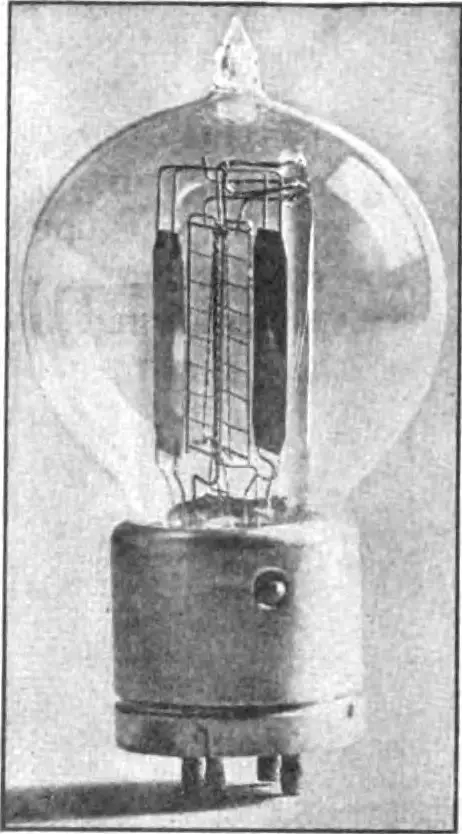
https://commons.wikimedia.org/wiki/File:Western_Electric_triode.jpg
Technical details of the triode’s operation and design
The principle of amplification in a triode is based on its ability to control a large current between the cathode and anode using a relatively small voltage applied to the grid. This control grid, situated between the cathode (electron emitter) and the anode (electron collector), modulates the flow of electrons in response to the input signal. The result is that small changes in the input signal produce larger changes in the output signal, thus amplifying it.
Circuit configurations for the triode varied depending on its application, ranging from simple amplifiers to more complex arrangements for oscillation and mixing of signals. The triode could be found in a variety of circuit configurations, such as common cathode amplifiers for voltage amplification, cathode followers for impedance matching, and Hartley and Colpitts oscillators for generating RF signals. These applications underscored the flexibility and utility of the triode in electronic design.
Impact of the triode on radio technology and amateur radio operations
The advent of the triode revolutionized radio communication and reception, enabling clearer, stronger, and more reliable radio signals over longer distances. Its ability to amplify weak signals transformed radio from an experimental curiosity into a viable medium for mass communication, laying the groundwork for commercial broadcasting, public safety networks, and long-distance communication.
For amateur radio enthusiasts, the triode opened new realms of possibilities. It enabled hams to build more powerful and sensitive receivers and transmitters, allowing them to make contact with fellow operators across greater distances and with greater clarity than ever before. The triode also facilitated the emergence of new modes of communication within the amateur radio community, such as voice (AM and SSB), significantly expanding the hobby’s scope and impact.
Later Career and Legacy
de Forest’s work in the 1920s and 1930s, including the development of television and FM radio
Lee de Forest made significant contributions to the early development of television, experimenting with mechanical and electronic methods for transmitting and displaying images. He was among the first to transmit human speech synchronously with images, laying groundwork for what would become television broadcasting. Despite facing competition and technical challenges, de Forest’s work helped to spur further innovation and development in the nascent television industry.
de Forest also played a pioneering role in the advancement of frequency modulation (FM) radio. He recognized early on the superior sound quality and reduced interference that FM offered over amplitude modulation (AM) radio. His early experiments and advocacy for FM technology were instrumental in its eventual adoption, despite initial resistance from the established AM broadcasting industry.
Later inventions and innovations, including the “phantom circuit” and “space charge tube”
Throughout his later career, de Forest continued to experiment and develop new technologies. One such innovation was the “phantom circuit,” which allowed for the transmission of two telephone calls or two telegraph messages simultaneously over a single wire, effectively doubling the capacity of existing telecommunication lines.
Another lesser-known but significant invention was the “space charge tube,” designed to improve the performance of vacuum tubes at very high frequencies. These and other inventions reflected de Forest’s ongoing commitment to advancing electronic technology, even as he transitioned from pioneering inventor to elder statesman in the field.
“I foresee great refinements in the field of short-pulse microwave signaling, whereby several simultaneous programs may occupy the same channel, in sequence, with incredibly swift electronic communication; vastly important developments in microwave technique, whereby present clumsy connecting leads between wall or floor sockets and electric devices like toasters and vacuum sweepers may become unnecessary; gigantic magnetrons and klystrons, or their successors, will generate megawatts in microwaves; living rooms and their occupants will be heated by high-frequency waves from walls or ceilings; short waves will be generally used in the kitchen for roasting and baking, almost instantaneously.”
“Dawn of the Electronic Age” January 1952 article by Lee De Forest in Popular Mechanics
de Forest’s legacy and influence on modern electronics and amateur radio
Lee de Forest’s lasting impact on the field of electronics is immeasurable. He is often hailed as one of the fathers of the “electronic age,” thanks to his development of the Audion tube and its subsequent improvements. These innovations laid the foundation for virtually all modern electronic devices, from radio and television to computers and mobile phones. His vision and inventions continue to underpin the fields of electronic communication and information technology.
de Forest’s work has also served as an inspiration for future generations of inventors and amateur radio enthusiasts. His spirit of exploration and innovation lives on in the amateur radio community, where experimentation and technological advancement continue to be hallmark values. de Forest’s belief in the power of communication and his contributions to its infrastructure have made him a venerated figure among hams worldwide, who see in his life’s work a model for their own pursuits in pushing the boundaries of what is possible in wireless communication.
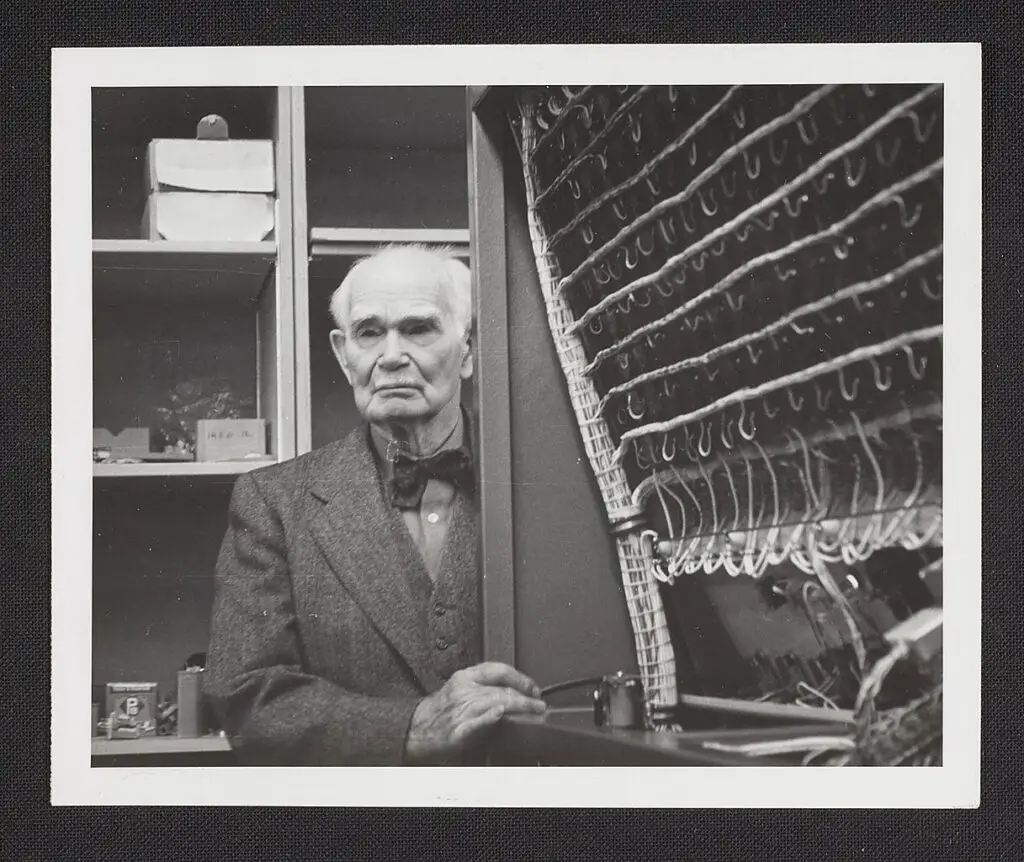
Controversies and Disputes
Patent disputes with other inventors, including Edwin Armstrong and Guglielmo Marconi
Throughout his career, Lee de Forest found himself entangled in several high-profile patent disputes with other prominent inventors, most notably Edwin Armstrong and Guglielmo Marconi. These disputes often centered around competing claims over foundational technologies in radio transmission and amplification. The clash with Armstrong was particularly contentious, revolving around the invention and use of feedback circuits and the regenerative receiver, while the disputes with Marconi dealt with broader claims to the invention of radio itself.
The outcomes of these disputes were mixed, involving protracted legal battles that sometimes lasted for years. In some cases, de Forest was successful in defending his patents, while in others, he faced setbacks. These controversies not only consumed significant financial resources but also shaped the development of radio technology, leading to clearer definitions of patents and intellectual property rights in the burgeoning field of electronics.
Accusations of plagiarism and intellectual property theft
de Forest was accused on several occasions of plagiarizing the work of other inventors and claiming innovations as his own that had been conceived by others. Critics pointed to his adaptation of the Audion tube as one of the most significant instances, suggesting that he had built upon the discoveries of John Ambrose Fleming without proper credit. Similarly, his work in radio transmission and amplification was scrutinized for its similarities to the work done by others in the field.
Evidence and arguments presented during these accusations often involved detailed technical analyses of the inventions in question, including patent filings, laboratory notebooks, and public demonstrations of technology. While de Forest maintained that his work was original and that any similarities were coincidental or the result of parallel innovation, detractors argued that critical aspects of his inventions had been derived from the works of others.
de Forest’s response to criticisms and controversies
de Forest was proactive in responding to criticisms and controversies, often taking to public forums, courtrooms, and the press to defend his work and reputation. He insisted on the originality of his inventions and highlighted his contributions to the field of electronics and radio communication. de Forest’s statements and defenses were sometimes marked by a defiant tone, as he sought to position himself as a pioneering inventor facing unjust attacks from competitors and detractors.
The impact of these controversies on de Forest’s reputation was complex. While some viewed him as a beleaguered genius fighting to protect his rightful place in the annals of scientific history, others saw him as a figure whose contributions were marred by questionable ethics and legal entanglements. Nevertheless, despite these disputes, de Forest’s legacy as a key figure in the development of electronic communication remains intact, with his pioneering work on the Audion tube and its role in the evolution of telecommunications acknowledged and celebrated.
Conclusion
Lee de Forest revolutionized electronic communication with his invention of the Audion tube, the first practical electronic amplifying device. This breakthrough laid the foundation for radio, television, and countless other technologies, shaping the 20th century’s electronic revolution. His contributions extend to signal modulation, early sound-on-film experiments, and improved vacuum tube designs.
de Forest bridged the gap between scientific theory and practical application, paving the way for broadcasting, public address systems, and radio’s widespread use in communication and entertainment. His impact is undeniable, placing him among the most influential figures in electronics alongside Tesla and Marconi.
de Forest’s legacy lives on in modern amateur radio, where the principles of the Audion tube remain fundamental to radio equipment and communication technology. His innovative spirit and willingness to push boundaries serve as an inspiration for today’s enthusiasts, encouraging exploration and experimentation to advance the hobby and discover new frontiers.
Further Reading
To learn more about the life of Lee de Forest , his inventions, and their impact on modern technology and amateur radio, the following books and links serve as comprehensive resources:
- “Lee de Forest: King of Radio, Television, and Film” by Mike Adams – This book covers the life of Lee de Forest , providing context to his inventions and their impact on current technology.
- “Empire of the Air: The Men Who Made Radio” by Tom Lewis – Offers a broader perspective on the early days of radio, including de Forest’s contributions alongside other pioneers.
- “The Continuous Wave: Technology and American Radio, 1900-1932” by Hugh G. J. Aitken – Provides an in-depth look at the development of radio technology in the early 20th century, with mentions of de Forest’s work.
- “Inventing American Broadcasting, 1899-1922” by Susan J. Douglas – This book delves into the evolution of broadcasting and includes discussions on de Forest’s influence.
- “The Early History of Radio: From Faraday to Marconi” by Giovanni Giacobello – Provides background on the scientific discoveries that led to the development of radio, setting the stage for de Forest’s innovations.
- “Scientists Greater than Einstein: The Biggest Lifesavers of the Twentieth Century” by Billy Woodward – Although focused on a variety of scientists, this book offers context on how de Forest’s work has impacted lives through modern technology.
- Lee De Forest page on Wikiquote.
- Lee de Forest on Wikipedia.
- The Lee de Forest archives of papers at Yale.
- Father of Radio: The Autobiography of Lee de Forest. (also here….)
- Britannica’s Entry on Lee de Forest
- LeedeForest.org
These resources offer a mix of detailed biographical insights, historical contexts, and technical analyses suited for readers looking to fully appreciate Lee de Forest’s lasting legacy in electronics and amateur radio.

